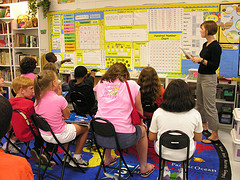Gravity is a wondrous thing. Given a high place and a low place, things can very easily be moved from high to low, by the reliable force that makes all things come down. But as we desire to move stuff from one place that is no higher than its destination, then we must rely on muscle. Muscle is effective, but it is limited and it insults the animal who is pressed into labor. So we invent engines.
In a world of economic mountains, gravity works very well for the few who live on the mountain tops, in exercising their dominance. But as the world becomes flat, muscle insults us all, so we invent engines — systems of supply chain that further flatten the world.
 What about an education system that is challenged to prepare children for their future — and it’s not their father’s future. So what about a flat classroom? Traditional education has been an environment of hills. The teacher could rely on gravity to support the flow of curriculum down to the learners. But as much as we might like to pretend, we (teachers) are no longer on top of the hill. The hill is practically gone.
What about an education system that is challenged to prepare children for their future — and it’s not their father’s future. So what about a flat classroom? Traditional education has been an environment of hills. The teacher could rely on gravity to support the flow of curriculum down to the learners. But as much as we might like to pretend, we (teachers) are no longer on top of the hill. The hill is practically gone.
For the first time in history, children are more comfortable, knowledgeable, and literate than their parents about an innovation central to society. (Tapscot)
In many cases, students communicate more, construct original content more, and more often collaborate virtually with other people, than do their teachers. Those teachers who pretend to stand on higher ground, appear, to many of their students, to be standing on quicksand.
I wax hyperbole, but the point is that our times require a different kind of classroom, one that can no longer rely on gravity. We must invent a perpetual learning engine.
I hope to spend the next couple of weeks talking through some ideas concerning a flat classroom learning engine, most of which I am still forming. But I would like to begin with a list of characteristics for students in a flat classroom learning engine.
- Curious
- Self Directed Learners
- Intrinsic need to communicate
- Intrinsic need to influence
- Future Oriented
- Heritage Grounded
I’ve constructed a wiki page where a lot of this content will be posted. You are invited to go in and hack the concepts, adding your 2¢ worth any where and at any time. I plan to start explaining what I mean by each of these characteristics in the next couple of days. But feel free to go ahead and do some writing in the wiki.
The wiki page is at: http://flatclass.davidwarlick.com/
Tapscott, Don. Growing Up Digital. McGraw-Hill: New York, 1998.

It’s an interesting concept but to what extent do you think students in the not-so-flat classroom are not curious, not self-directed, uncommunicative, etc? Is it the students per se that have changed or their environment? The classroom environment is ever changing is it not?
What is the role of the classroom, to transmit information (the stuff kids now have unlimited access to and probably what you were referring to in your piece) or to foster knowledge and wisdom (arguably what you don’t automatically get just by surfing the web or instant messaging)? It’s a truism that today’s greatest thinkers were educated in yesterday’s classrooms, and I’m not sure they were flat in the sense you mean.
I work as a high school teacher, and while kids know how to google, they are even worse than my generation at telling the difference between information and drivel. There is a worrying tendency to treat anything on the ‘net as fact, even when the ‘facts’ contradict each other they somehow believe both.
Some kids have great IT skills, but just as many are only able to perform simple, familiar tasks, even amongst the more ‘gifted’
I don’t know what you mean by flat – the belief that all kids are curious is simply untrue – different backgrounds mean different values, and many come from backgrounds that emphasise doing and have little or no time for knowing.
I am very interested on the flat classroom concept, it is seriousy imperative for the open source community to continue to integrated platforms that bring all web 2.0 technologies in creating the standard scalable classroom of the future